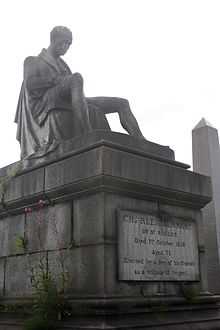Patric Park
| Patric Park RSA, ARSA | |
|---|---|
 Posthumous portrait, from photograph, by Kenneth Mcleay | |
| Born |
12 February 1811 Glasgow, Scotland |
| Died |
16 August 1855 (aged 44) Warrington, England |
| Nationality | Scottish |
| Occupation | Sculptor |
Patric Park (born 12 February 1811, Glasgow; died 16 August 1855, Warrington[1]) was a Scottish sculptor.[2]
At around age 14, he was apprenticed to Edinburgh mason John Cornell.[1] From 1828 he worked with the architect James Gillespie Graham.[1]
From 1831–1833 he studied in Rome under Bertel Thorvaldsen.[2] He was regarded as one of Scotland's finest portrait sculptors.[2] His subjects included the miniaturist Kenneth Mcleay (1802-78), who in turn made a posthumous portrait of Park, from a photograph, shown above.[2]
He was elected to the Royal Scottish Academy and exhibited there and at the Royal Academy.[1]
After living in Edinburgh and London, he was living in Manchester, when he died suddenly in Warrington.[1]

Two of his busts, depicting Admiral Thomas Cochrane, 10th Earl of Dundonald, and Sir James Young Simpson, discoverer of chloroform, are in the Scottish National Portrait Gallery.[3] His 1838 seated marble figure of Charles Tennant of St Rollox is on Tennant's tomb at the Glasgow Necropolis. His 1845 bust of Robert Burns is in the Robert Burns Birthplace Museum[4] and his bust of Napoleon III, purchased from the Paris International Exhibition in 1855, is in the Victoria and Albert Museum.[5]
References
- ↑ 1.0 1.1 1.2 1.3 1.4 "Patric Park". Mapping the Practice and Profession of Sculpture in Britain and Ireland 1851-1951. University of Glasgow. Retrieved 3 June 2013.
- ↑ 2.0 2.1 2.2 2.3 "Patric Park, 1811 - 1855. Sculptor − Kenneth MacLeay". National Galleries of Scotland. Retrieved 3 June 2013.
- ↑ "Patric Park". National Galleries of Scotland. Retrieved 3 June 2013.
- ↑ "Bust of Robert Burns by Patric Park, 1845". Burns Scotland. Retrieved 3 June 2013.
- ↑ "Napoleon III (1808-1873)". Victoria and Albert Museum. Retrieved 3 June 2013.